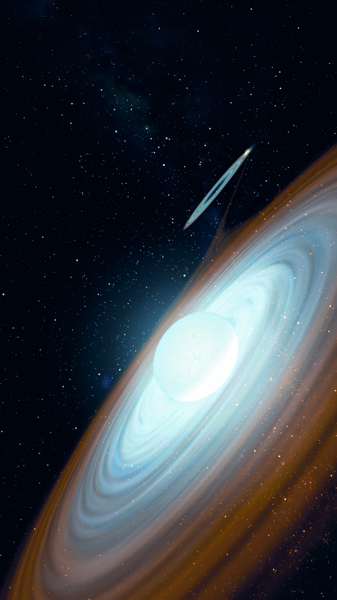Researchers discover the first black hole orbiting a ‘spinning’ star [NOT TRANSLATED]

A group of scientists, three of them members of the IEEC, have discovered the first binary system ever known to consist of a black hole and a ‘spinning’ star – or more accurately, a Be-type star. Although predicted by theory, none had previously been found. The observations that led to the discovery were performed with the Liverpool and Mercator telescopes at the Observatorio del Roque de los Muchachos (Canary Islands, Spain). The discovery is published today in Nature.
Be-type stars are quite common across the Universe. In our Galaxy alone more than 80 of them are known in binary systems together with neutron stars. ‘Their distinctive property is their strong centrifugal force: they rotate very fast, close to their break-up speed. It’s like they were cosmic spinning tops,’says Jorge Casares of the Instituto de Astrofísica de Canarias (IAC) and La Laguna University (ULL). Casares is the lead author and an expert in stellar-mass black holes (he presented the first solid proof of their existence back in 1992).
The newly discovered black hole orbits the Be star known as MWC 656, located in the constellation Lacerta (the Lizard) – 8,500 light years from Earth. The Be star rotates so fast that its surface speed exceeds 1 million kilometres per hour. ‘We started studying this star back in 2010, when space telescopes detected transient gamma-ray emission coming from its direction,’ explains Marc Ribó, of the Institut de Ciències del Cosmos of Barcelona University (ICC/IEEC-UB). ‘No more gamma-ray emission has subsequently been detected, but we found that the star was part of a binary system,’ he adds.
A detailed analysis of its spectrum allowed scientists to infer the characteristics of its companion. ‘It turned out to be an object with a mass between 3.8 and 6.9 solar masses. An object like that, invisible to telescopes and with such large mass, can only be a black hole, because no neutron star with more than three solar masses can exist,’ states Ignasi Ribas, of CSIC in the Instituto de Ciencias del Espacio (IEEC-CSIC).
The black hole orbits the (more massive) Be star and is fed by matter ejected from the latter. ‘The high rotation speed of the Be star causes matter to be ejected into an equatorial disc. This matter is attracted by the black hole and falls on to it, forming another disc – called an “accretion dis”’. By studying the emission from the accretion disc we could analyse the motion of the black hole and measure its mass,’ comments Ignacio Negueruela, a lecturer at the University of Alicante (UA).
Scientists believe this object to be a nearby member of a hidden population of Be stars paired with black holes. ‘We think these systems are much more common than previously thought, but they’re difficult to detect because their black holes are fed from gas ejected by the Be stars without producing much radiation, in a “silent” way, so to speak. However, we hope to detect other similar binary systems in the Milky Way and other nearby galaxies by using bigger telescopes, such as the Gran Telescopio Canarias,’ concludes Casares.
The biggest problem in detection of black holes is put forth by ‘dormant’ black holes, such as the one found by the Spanish researchers: ‘Their X-ray emission is almost absent, and so it is very unlikely that our attention would be drawn to them,’ Casares explains. Researchers believe there are thousands of black hole binary systems across the Milky Way, some of them also with Be-type stellar companions.
Article:
J.Casares, I.Negueruela, M.Ribó, I.Ribas, J.M.Paredes, A.Herrero, S.Simón-Díaz. A Be-type star with a black-hole companion. Nature. DOI: 10.1038/nature12916
estrella_be_agujero_negro_portada_nature_limpia
The Be star spins at extremely high velocidad, ejecting matter through an equatorial disc. Part of this matter falls on to the black hole forming an accretion disc.
IEEC in the media:
http://www.rtve.es/noticias/20140115/descubren-primer-agujero-negro-orbitando-alrededor-estrella-peonza/850181.shtml
http://www.abc.es/ciencia/20140115/abci-primer-agujero-negro-orbita-201401151755.html
http://www.larazon.es/detalle_normal/noticias/5113332/sociedad+ciencia/el-agujero-negro-y-la-estrella-peonza-la-pareja-mas-escurridiza#.Uteip9LuKYE
http://www.publico.es/495514/cientificos-espanoles-descubren-el-primer-agujero-negro-que-orbita-una-estrella-peonza
http://www.elnuevoherald.com/2014/01/15/1656681/un-agujero-negro-y-una-estrella.html
http://www.agenciasinc.es/Noticias/Descubierto-el-primer-agujero-negro-orbitando-alrededor-de-una-estrella-peonza
http://www.20minutos.es/noticia/2030443/0/agujero-negro/estrella-peonza/pareja-cosmica/
http://www.elcorreo.com/vizcaya/20140115/mas-actualidad/sociedad/investigadores-espanoles-descubren-primer-201401151934.html
http://www.teinteresa.es/espana/INVESTIGADORES-ESPANOLES-DESCUBREN-AGUJERO-ESTRELLA_0_1066695089.html
http://actualidades.es/noticias/un-agujero-negro-y-una-estrella-peonza-una-singular-pareja-cosmica
http://gloria.tv/?media=556167
http://allan-astronomia.blogspot.com.es/2014/01/un-agujero-negro-y-una-estrella-peonza.html#.UtejGtLuKYE
http://www.finanzas.com/noticias-001/ciencia/20140115/primer-agujero-negro-orbita-2584729.html
http://www.elnuevodiario.com.ni/fotos/986
http://noticieros.televisa.com/mundo/1401/descubren-agujero-negro-orbitando-estrella-peonza/
http://tecnologia.blobic.com/entry/descubierto-el-primer-agujero-negro-orbitando-alrededor-de-una-estrella-peonza-noticias-sinc
https://www.google.es/url?sa=t&rct=j&q=&esrc=s&source=web&cd=17&cad=rja&ved=0CEAQFjAGOAo&url=http%3A%2F%2Fwww.fisicahoy.com%2Fnoticia%2Fdescubierto_el_primer_agujero_negro_orbitando_alrededor_de_una_estrella_peonza&ei=FKPXUoXMF4mr0QW0tICACA&usg=AFQjCNHUW5fnMGJXSoF6N3k5_QGRoV9qfA&bvm=bv.59568121,d.d2k
http://home.canalsonora.com/el-primer-agujero-negro-que-orbita-una-estrella-peonza/
https://www.google.es/url?sa=t&rct=j&q=&esrc=s&source=web&cd=19&cad=rja&ved=0CEcQFjAIOAo&url=http%3A%2F%2Fwww.solociencia.com%2F2014%2F01%2F16%2Fdescubierto-el-primer-agujero-negro-orbitando-alrededor-de-una-estrella-peonza%2F&ei=FKPXUoXMF4mr0QW0tICACA&usg=AFQjCNEohHJQuCTL6iOfD0GdvRIsumUxUQ&bvm=bv.59568121,d.d2k
http://es.covertimes.com/featured/investigadores-espanoles-descubren-primer-agujero-negro-que-orbita-estrella-peonza/3058847
http://www.eleconomista.es/interstitial/volver/nuezene14/sociedad/noticias/5461521/01/14/Investigadores-espanoles-descubren-el-primer-agujero-negro-que-orbita-en-torno-a-una-estrella-peonza.html
http://www.tabascohoy.com/2/notas/index.php?ID=170762
http://www.iberoamerica.net/espana/prensa-generalista/cope.es/20140115/noticia.html?id=OXo1lZd
http://www.correodelorinoco.gob.ve/ciencia-tecnologia/cientificos-espanoles-descubren-agujero-negro-que-orbita-una-estrella/
http://www.innovaticias.com/ciencias/20938/noticia-innovacion-descubre–primer-agujero-orbita-estrella-peonza [NOT TRANSLATED]
